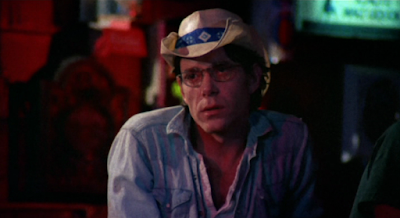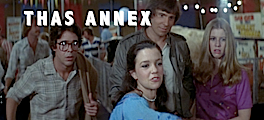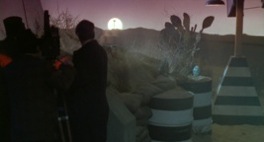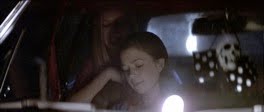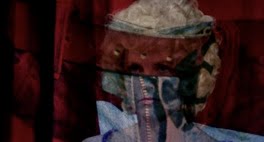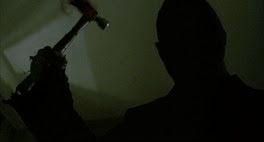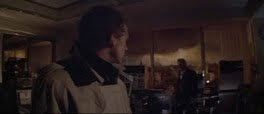Djinn is the dissoluble remains left behind from the evaporation of Hooper's expansive career experimenting with distanciation, expressionism, sentimentalism, theatricality, irony and impressionism. It is alternatively at one - that is, soluble - with Hooper's varied attempts in cinematic exploration, yet also, when separated, totally and materially unique, the result of the distillation of Hooper's richly aqueous career. All commercial moisture is drained and what is left is the particles of his most undiluted eccentricities and experimental impulses. Even Spielberg embraced a theatrical minimalism with Lincoln (before reverting with a purer form of Ford idolatry in War Horse), although Spielberg does not so much "pare down" as he does "grab unduly for the hearts of the populace," barely finding himself were it not for himself being the heart of the industry (of myth-making) itself. Spielberg creates Fordian myth, full of archetypes; Djinn is perhaps the closest honoring of the fairy tale the cinema has achieved - strange, inexact and free of the formulaic modifications of mythological/commercial packaging, instead allowing a sense of mundane reality to be warped by the uneasy lessons of fantastic circumstances, allowing its moderately-budgeted production to be carrier of a small-scale dramatic storyline curious about the topics of relationships, culture, cultural placement, superstition, and modernity.
Djinn's images I find incredibly comforting. DP Joel Ransom's RED One cinematography is flat and almost documentary-like, and, as utilized by Hooper and screenwriter David Tully's tale of denizens of the modern GCC, suggests the fairy tale's capacity for dropping everyday figureheads into the harsher realms of storytelling. What is cinematic about Djinn is in its ideas, not its images and any sort of industrialized sense of photography, whether Cronenberg's digital poise or Spielberg's traditionalist beauty. Djinn is sandblasted (desert pun not intended) of cinema, without detriment to it as the film is incredibly striking as a visual piece regardless. It has no tradition in cinema, all the better to present a modern fairy tale and the old world Ras al-Khaimah that slowly infiltrates the modern seaside highrise of the film.
It's a fascinating addition to Hooper's interest in stories of modern versus old traditions, in cultural states of flux that impinge on each other, a thematic lineage seen through Texas Chain Saw Massacre (and Eggshells) to Lifeforce and Night Terrors (films in which sexual cultures both arrest and propel spiritual or moral progress, and in which geographic-cultural boundaries are very specifically placed). Like Texas Chainsaw Massacre's Sawyer clan expanding into 80s capitalism for its sequel, here the djinn have passive-aggressively expanded their domain into modern real estate, both representing it and subverting it (just like the Sawyers), both welcoming and damning the materialist humans who have claimed their mastery over such matters of modern life. Djinn, within its non-pedantic bones, is about modernity and the anti-compromise with modern humans' questionable trajectories, here on a remarkably relevant scale of global purview (integral to question the film its vagaries: why does the film's heroine Salama commit the pivotal crime she does? What is the true focus of the djinn's cruel manipulations? Is not globalization an inherent part of modern development? All this simply connects back to the clash between the husband and the wife, a localizing of East versus West concerns, and the djinn's aggressions are explicitly a reaction against these diverse but interrelated syndromes of a modern world).
The opening portion of Djinn (its main passage, that is, past the prologue with the American backpacker) is pure rituals of family. Djinn's family is one of the most remarkable I've seen in a film personally, Hooper's representation a sweet and ever-so-slightly ironical concentration of all the unreality of family.
There is something I find terribly unimaginative about editor Andrew Cohen's work for Hooper. The above scene is terribly curt. I am not saying he is a bad editor, nor not a talented one, but that his editing rarely goes above and beyond in sculpting any of the works he has done with Hooper beyond Hooper's rather plain directorial frameworks, in taking control of scenes, stretching them to their potential, whilst they are often marred by images and feelings not left lasting enough, or by unfortunate over-cutting. But going along with the fact that he is no Thelma Schoonmaker is the fact that Hooper is no Scorsese, either. They have complimented each other well, Toolbox Murders being filled with a number of expert moments of beautiful fluidity, Dance of the Dead harnessing the expertise of Cohen's fast editing put to exquisite and melodic use, and, in Djinn, it's to not get in the way of Hooper's "project of normality," of cinema without cinema's grandeur or mystery. Djinn is plain and grounded, its montage unshackled to a certain level of freedom, a resistance to any dogmatism of the image, cinema less of cinema but with ideas and reality placed in the forefront. Genre cinema is proven it can be something else.
A fascinating dichotomy is instantly created by the introduction of, not one, but two religious talismans gifted to Salama by her superstitious mother. One wards off envy, the other evil - the film once again complicates the matter of what the threat is, of what complex ideas and emotions really endanger this couple.
The Mother of Mother-Bitch shots,
and that is completely complimentary. She is awesome.
The parents are cunningly utilized to steal the show early in the film, their quips and humor resounding in the dual purposes of levity and simultaneous characterization: they are old-fashioned patriarchy and matriarchy as vaudeville tokens, the family clearly serving as the two protagonists' first encounter upon arrival with the successive slidings of the old versus the new.
The Texas Chainsaw Massacre 2/Stretch shot. "Inwardly-rebelling gal faces down a hallway" shot.
































































